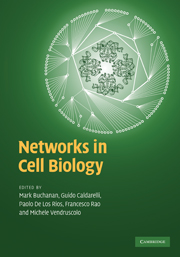Book contents
- Frontmatter
- Contents
- List of contributors
- Introduction
- 1 Network views of the cell
- 2 Transcriptional regulatory networks
- 3 Transcription factors and gene regulatory networks
- 4 Experimental methods for protein interaction identification
- 5 Modeling protein interaction networks
- 6 Dynamics and evolution of metabolic networks
- 7 Hierarchical modularity in biological networks: the case of metabolic networks
- 8 Signalling networks
- Appendix A Complex networks: from local to global properties
- Appendix B Modelling the local structure of networks
- Appendix C Higher-order topological properties
- Appendix D Elementary mathematical concepts
- References
- Index
2 - Transcriptional regulatory networks
Published online by Cambridge University Press: 05 June 2012
- Frontmatter
- Contents
- List of contributors
- Introduction
- 1 Network views of the cell
- 2 Transcriptional regulatory networks
- 3 Transcription factors and gene regulatory networks
- 4 Experimental methods for protein interaction identification
- 5 Modeling protein interaction networks
- 6 Dynamics and evolution of metabolic networks
- 7 Hierarchical modularity in biological networks: the case of metabolic networks
- 8 Signalling networks
- Appendix A Complex networks: from local to global properties
- Appendix B Modelling the local structure of networks
- Appendix C Higher-order topological properties
- Appendix D Elementary mathematical concepts
- References
- Index
Summary
Introduction
Complex systems that describe a wide range of interactions in nature and society can be represented as networks. In general terms, such networks are made of nodes, which represent the objects in a system, and connections that link the nodes, which represent interactions between the objects. In mathematical terms, a network is a graph which comprises of vertices and edges (undirected links) or arcs (directed links). Examples of complex networks include the World Wide Webs, social network of acquaintances between individuals, food webs, metabolic networks, transcriptional networks, signaling networks, neuronal networks and several others. Although the study of networks in the form of graphs is one of the fundamental areas of discrete mathematics, much of our understanding about the underlying organizational principles of complex real-world networks has come to light only recently. While traditionally most complex networks have been modeled as random graphs, it is becoming increasingly clear that the topology and evolution of real networks are not random but are governed by robust design principles.
A number of biological systems ranging from physical interaction between biomolecules to neuronal connections can be represented as networks. Perhaps the classic example of a biological network is the network of metabolic pathways, which is a representation of all the enzymatic inter-conversions between small molecules in a cell. In such a network, nodes represent small molecules, which are either substrates or products of an enzymatic reaction, and directed edges represent an enzymatic reaction that converts a substrate into a product.
- Type
- Chapter
- Information
- Networks in Cell Biology , pp. 14 - 35Publisher: Cambridge University PressPrint publication year: 2010



